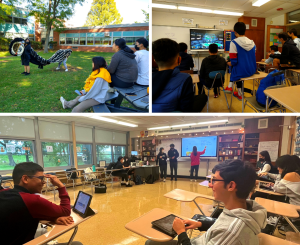A Brief Guide to Research Databases
June 7, 2023
Whether it be in high school, college, or a future workplace, research is an essential skill that is vital for success in your educational journey or career. The basis of significant research rests on the review and application of past literature; as a result, a trustworthy database is a necessity for researchers.
In this article, I have reviewed six standard academic research databases that are accessible to South High students. I have also given each database a rating, based on accessibility, credibility, indexing features/searching capabilities, scope and discipline, and aesthetics/presentation.
★★★☆☆
Scope: over 12 million journal articles
Discipline: multidisciplinary
JSTOR (aka “Journal Storage”) is a digital library comprising academic journals in humanities and the sciences, as well as a limited collection of books and other primary sources (such as images). Access is provided through Great Neck South High.
JSTOR collections are highly curated, and all academic journals go through a selection process, reviewing journal ranking, citation data, quality of research, etc., making the database highly trusted and used by researchers. There is a general search bar on the homepage to search text and images. JSTOR supports full-text searches of every source; however, this returns a broad range of results, and so the terms you inputted may not be the main topic of some articles. JSTOR does have an advanced search feature, which allows for filtering by subject or journal, along with access and item type. Some content and journals may not be current, due to the “moving wall” limitation of most journals on JSTOR, which controls a disparity between the volumes available on JSTOR and the most up to date volume of the journal.
Because the content is mostly journals and primary sources, articles are displayed as an embedded document/book format rather than direct text; as a result, you cannot directly copy and paste from many of the articles, or format the text your own way after downloading. In addition, I personally enjoy skimming through abstracts to determine which articles fit the general premise of my research; many articles on JSTOR do not contain a general synopsis, and so especially if your key term is not a major focus of the article, it can be difficult to narrow down and curate your search results.
Overall, JSTOR is a great resource for full-text journals and trustworthy information, but may not provide access to the most current issues and may not be as beginner-friendly or concise as some other databases.
★★★★☆
Scope: over 19 million items (over 1,800 journals, over 6.5 million articles and 60 million abstracts)
Discipline: multidisciplinary
ScienceDirect is a large database of publications by Elsevier, a Dutch publisher. The journals are compartmentalized into four content areas (comprising 24 subcategories): Physical Sciences and Engineering, Life Sciences, Health Sciences, and Social Sciences and Humanities. Article abstracts are free to the public, which allows you to efficiently find articles that pertain to your topic without having to comb through the full text. Access to parts of the database is provided through Great Neck South High.
Articles hosted on ScienceDirect are peer-reviewed and come from scholarly publications. It has a straightforward interface; its advanced search tools and filtering mechanisms allow you to narrow down results to just research articles and review articles, and you can also search text or just title/abstracts. However, the search is only limited to Elsevier products (around 2,500 journals).
My favorite feature of ScienceDirect is the interconnectivity of its platform and content. The site incorporates different topic pages, which can be accessed through hyperlinked topics in the text of articles, containing an overview and related terms of that particular topic. Its author pages, topic pages, and recommended content allow researchers to explore related material and reach a broad scope across all four major content areas.
★★★★☆
Scope: articles from over 19,000 scholarly journals
Discipline: multidisciplinary
Academic Onefile is a product by Gale, a company that focuses on educational publishing for libraries and businesses. Gale itself produces hundreds of products, and Great Neck South provides access to its numerous specialized databases, which cover a wide range of topics.
Gale’s filtering tools allow you to explore only peer-reviewed articles and full-text documents, and you can curate results based on document type. The platform is very user-friendly, especially for high school students, and you can save articles directly to your Google Drive. In addition, citation information is very clearly displayed in standard format at the topic of the article page, and you have access to related article recommendations.
Gale Academic OneFile also has features such as the Topic Finder and Subject Guide Search, which can help you narrow down the premise of your topic or establish context around your topic. One minor issue I find with Gale databases (along with many others) is that the filters you apply to your search after inputting the key term (e.g. querying for only peer-reviewed articles, filtering by publication date, etc.) do not save or carry over into your next search, which can be mildly bothersome, especially when conducting multiple rounds of searching with different key terms.
Aside from OneFile, Gale In Context databases are great first-step resources that provide essays and background information on issues related to your research topic.
★★★☆☆
Scope: over 35 million citations and abstracts
Discipline: medicine and biological sciences
PubMed, a free search engine, is the free version of the MEDLINE databases (indexing around 5200 journals), which has references and abstracts on biomedical content, and is maintained by the United States National Library of Medicine (NLM) at the National Institutes of Health, making it the one of the leading sources of biomedical literature.
Because it is publicly available, PubMed is an accessible search tool for life science and biomedical research, and is overall reliable and authoritative, though each article should be further evaluated for accuracy, time period, acceptance, and whether or not it is peer-reviewed.
PubMed has Advanced Search, or the MeSH Database (Medical Subject Headings), of which the features Search Builder and Search History allow you to build very detailed and comprehensive searches. MeSH controls words used to index MEDLINE articles, and may require certain search strategies (such as the use of tags, limits, etc.).
PubMed’s interface is a bit confusing, especially for use in high school research, and its search tools also require a bit more thought and effort to use optimally. It also does not necessarily contain links to full-text sources, though its large corpus of articles can introduce you to or provide a general foundation for the premise of your research topic.
★★★☆☆
Scope: around 160 million indexed documents
Discipline: multidisciplinary
Google Scholar is a search engine (more of a search tool than a database) for academic literature. It is free and publicly available for open access scholarly resources, and it is also familiar and easy to use because it has a similar format as a standard Google search.
You can build and save articles to your library on the interface, and easily get citations for various articles; however, further determination should be made by the researcher on the reliability of the sources. Information is indexed from many worldwide academic publishers and repositories, and is mainly meant to help with broad searches for literature. It covers a lot of material, and also is a citation index; however, Google Scholar is not manually curated like some other databases, so it may contain computer errors and lack key studies or pertinent articles that some more specialized databases can offer you.
Google Scholar’s searching capabilities may also be more limited than the advanced searches of some databases (e.g. truncation), and it searches through limited fields. In addition, results are ranked by citations and relevance, and the beginnings of the results list may not contain the best, most trustworthy sources.
Overall, Google Scholar is a useful, ubiquitous starting point for research and is very user-friendly, though the quality of the articles should be cross-referenced and taken into consideration.
Gale Opposing Viewpoints in Context
★★★★☆
Scope: 20,000 pro/con viewpoints and around 19,000 reference articles
Discipline: multidisciplinary
Gale Opposing Viewpoints is a database that contains information, in the form of viewpoints, articles, videos, news, primary source documents, etc., on current debates, social issues, and controversial topics. Access is provided through Great Neck South High.
The database has many similar features as Gale Academic OneFile, which is described above. However, Opposing Viewpoints is in particular useful when writing argumentatively about controversial issues, or for debates, given that the resources in the database offer differing views on a wide range of topics. The database is well used as a starting point for research, as it offers in-depth sources centered around many common issues, along with pro/con articles, easily allowing the researcher to establish context and formulate an argument.
A unique feature of Opposing Viewpoints is its periodical content, covering many news and commentary channels that discuss current issues, such as The New York Times, Newsweek, and American Scientist. Similar to other Gale databases, Opposing Viewpoints has a Topic Finder, along with a total of 447 issue categories including economics, politics, the environment, and science, along with a category on National Debate Topics.
















